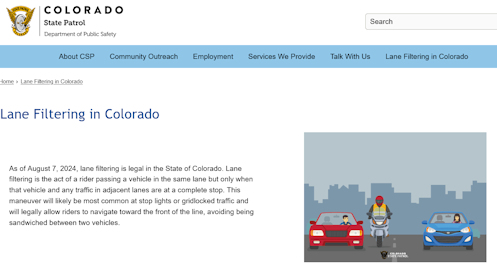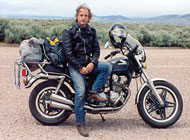Misinformation On Colorado Filtering Law
I’ll take a break from recounting the latest OFMC trip today because this is timely and really flagrant.
Lane filtering becomes legal in Colorado this week, on August 7. As a surprise to no one, I picked up several articles addressing this change and “informing” the readers of what it means. I put “informing” in quotes because all three pieces I saw, including one from the Colorado State Patrol (CSP), were clearly written by someone who does not ride motorcycles and who fails to understand the entire procedure. More importantly, they were just flat wrong.
Because the other articles seem to have been written based on what CSP put out I’ll go right to the source.
“The rider must pass on the left and not enter the oncoming traffic lane.”
What’s wrong here? Picture this. You have two lanes of traffic going each way and you are a rider in the left lane. You “must pass on the left”? I don’t think so. That would have you partially encroaching on the oncoming lane of traffic, which is strictly prohibited. Your only choice is to pass between the two lanes of traffic going your direction, which in this case would mean passing on the right. Either that or else if you’re in the left lane you are not permitted to filter. I’m pretty sure that’s not what is intended.
What the law actually says is this: A PERSON OVERTAKING OR PASSING PURSUANT TO THIS SUBSECTION (3)(b) SHALL NOT OVERTAKE OR PASS:
(A) ON THE RIGHT SHOULDER;
(B) To THE RIGHT OF A VEHICLE IN THE FARTHEST RIGHT-HAND LANE IF THE HIGHWAY IS NOT LIMITED ACCESS
(C) IN A LANE OF TRAFFIC MOVING IN THE OPPOSITE DIRECTION.
So that pretty much stipulates that you have to filter between lanes going your direction.
The CSP piece also said this: “The lane must be wide enough to fit the vehicle and motorcycle while passing.”
Now, not very many lanes anywhere are wide enough to allow a car and a motorcycle to fit comfortably side by side. The motorcycle needs to ride down the stripe separating the lanes. The law states filtering is permitted if “THE DRIVER OF THE TWO-WHEELED MOTORCYCLE IS ON A ROAD WITH LANES WIDE ENOUGH TO PASS SAFELY.”
Notes the plural there: “lanes.” And nothing about staying in the same lane as the car you’re passing.
I think part of the confusion may come from the wording of the law where it says “THE DRIVER OF A TWO-WHEELED MOTORCYCLE MAY OVERTAKE OR
PASS ANOTHER MOTOR VEHICLE IN THE SAME LANE AS THE MOTORCYCLE IF . . .” Maybe whoever wrote this piece read it to mean you can pass another vehicle only if you stay in the same lane that it is in, when in fact it should be read that you can pass another vehicle THAT IS in the lane you are in but you don’t have to stay completely in that one lane in doing so. A significant difference of meaning. So the law could have been written a bit more clearly.
So anyway, reading through the law again I spotted one thing this time that I did not notice previously. This is item B in the list above. “SHALL NOT OVERTAKE OR PASS: (B) To THE RIGHT OF A VEHICLE IN THE FARTHEST RIGHT-HAND LANE IF THE HIGHWAY IS NOT LIMITED ACCESS.”
“If the highway is not limited access.” Does this mean that they are specifically allowing you to overtake or pass on the right of the vehicle in the farthest right lane if the highway IS limited access? As in, if you’re on the interstate you can pass on the shoulder? It had not been my understanding that that was the intention of the Legislature but that does seem to be the logical reading of that rule.
At the same time, it also says this: “(III) A PERSON OVERTAKING OR PASSING PURSUANT TO THIS SUBSECTION (3)(b) SHALL NOT OVERTAKE OR PASS: (A) ON THE RIGHT SHOULDER;”
This seems contradictory. If anyone can clarify this for me I would appreciate it.
I think there are some kinks here. I suspect that there are going to be some amendments needed. But get ready because filtering will be here this week.
Biker Quote for Today
I don’t love the people driving fast, that’s the reason why I overtake them.

